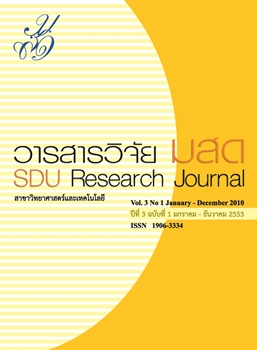การพัฒนาประสิทธิภาพที่อุดหูจากยางธรรมชาติ
Keywords:
ยางธรรมชาติ, ที่อุดหู, เครื่องวัดเสียง, Ear plugs, Natural rubber, Sound level meterAbstract
บทคัดย่อ
การพัฒนาประสิทธิภาพที่อุดหูจากยางธรรมชาติ เป็นการศึกษาเพื่อหาประสิทธิภาพที่อุดหูที่ผลิตขึ้นจากยางธรรมชาติและหาความสัมพันธ์ของการลดเสียงระหว่างที่อุดหูจากยางธรรมชาติต้นแบบกับชนิดที่มีขายอยู่ตามท้องตลาดซึ่งวิธีการคือการใช้ยางธรรมชาติมาใช้เป็นวัตถุดิบหลัก โดยการปรับปรุงกระบวนการลดปริมาณการกระจาย 50%ของกำมะถันลง 50% จากสูตรการผลิตฟองน้ำ แล้วนำมาทดสอบประสิทธิภาพในการลดเสียงด้วยเครื่องตรวจวัดระดับการได้ยิน (Audiometer) ที่ความถี่ ทั้ง 9 ระดับ ซึ่งได้แก่ 125 - 8000 เฮิร์ซ (Hertz, Hz) โดยการเลือกตัวอย่างจำนวน64 คน มาทำการตรวจวัดระดับการได้ยินด้วยเสียงบริสุทธิ์ (Pure tone) โดยทำการซ้ำการทดลองละ 3 ซ้ำ เพื่อคำนวณหาค่าการลดเสียงในแต่ละความถี่จากผลของระดับการได้ยินเมื่อใส่และไม่ใส่ที่อุดหู พบว่า ที่อุดหูต้นแบบมีค่าการลดเสียงได้มากกว่า 15 เดซิเบล (decibel, dB) ที่ทุกความถี่ ด้วยระดับความเชื่อมั่นร้อยละ 90 (P-value < 0.10) ซึ่งไม่มีความแตกต่างกันในด้านประสิทธิภาพการลดเสียงเมื่อเปรียบเทียบกับชนิดที่ขายตามท้องตลาด โดยมีความสัมพันธ์ของการลดเสียงเป็นไปในทิศทางเดียวกัน ด้วยค่าสัมประสิทธิ์สหสัมพันธ์ (0.260-0.771) ที่ระดับความเชื่อมั่นร้อยละ 90สำหรับการหาค่าอัตราการลดเสียงของอุปกรณ์ป้องกันเสียง พบว่า ที่อุดหูต้นแบบและที่อุดหูที่ขายตามท้องตลาดมีค่าอัตราการลดเสียงเมื่อสัมผัสกับเสียงความถี่สูง เท่ากับ 18.9 dB และ 25.6 dB และมีค่าอัตราการลดเสียงเมื่อสัมผัสกับเสียงที่ความถี่ต่ำ เท่ากับ 18.7 dB และ 25.5 dB ตามลำดับ ซึ่งค่ามาตรฐานการได้รับฟังเสียงดังไม่เกิน 96.1 dBตลอดระยะเวลาการทำงานต่อเนื่อง 8 ชั่วโมง
คำสำคัญ : ยางธรรมชาติ; ที่อุดหู; เครื่องวัดเสียง
Abstract
This research was a study to determine the efficiency of earplugs made from natural rubber and to findthe correlation for noise reduction rate of earplug made from natural rubber with that of commercial earplugs.The earplugs were designed and developed from natural rubber by reducing 50% of sulfur dispersion from latexfoam rubber standard formula. Then the developed earplug was tested on noise attenuation efficiency incomparison with that of the equivalent imported earplugs by using audiometer at 9 frequency levels ranging from 125 to 8000 Hertz (Hz). The sample group for the testing consisted of 64 normal hearing subjects whowere tested with a pure tone hearing threshold. The testing was carried out 3 times to calculate for noiseattenuation rate under the conditions of wearing and without wearing earplugs of both the natural rubber andcommercial plugs. Attenuation value at each frequency was obtained from the difference between hearingthreshold levels of subjects with and without earplugs. It was found, from the results of the experiment, that thenatural rubber earplugs were able to attenuate the noise of over 15 decibels (dB) at all of frequencies with 90%confidence interval (P-value < 0.10). Besides, the attenuation efficiency of the natural rubber earplugs is notsignificantly different from that of the commercial plugs. Furthermore, the noise attenuation rates of the naturalrubber plugs and the commercial plugs had the relatively high value of correlation coefficient (r = 0.260 -0.771) with 90% confidence level. The attenuation value of the natural rubber plugs which was calculatedaccording to the specifications of the US Environment Protection Agency (EPA) yields a noise reduction rate(NRR) of 18.9 dB when exposed to high frequency noise and a noise reduction rate (NRR) of 18.7 dB whenexposed to low frequency noise. On the other hand, commercial plugs yield R and NRR values of 25.6 and 25.5dB, respectively. The natural rubber plugs could reduce a noise at the maximum of 91.6 dB in the workplace attime weighted average exposure of 8 hrs.
Keywords : Ear plugs; Natural rubber; Sound level meter








